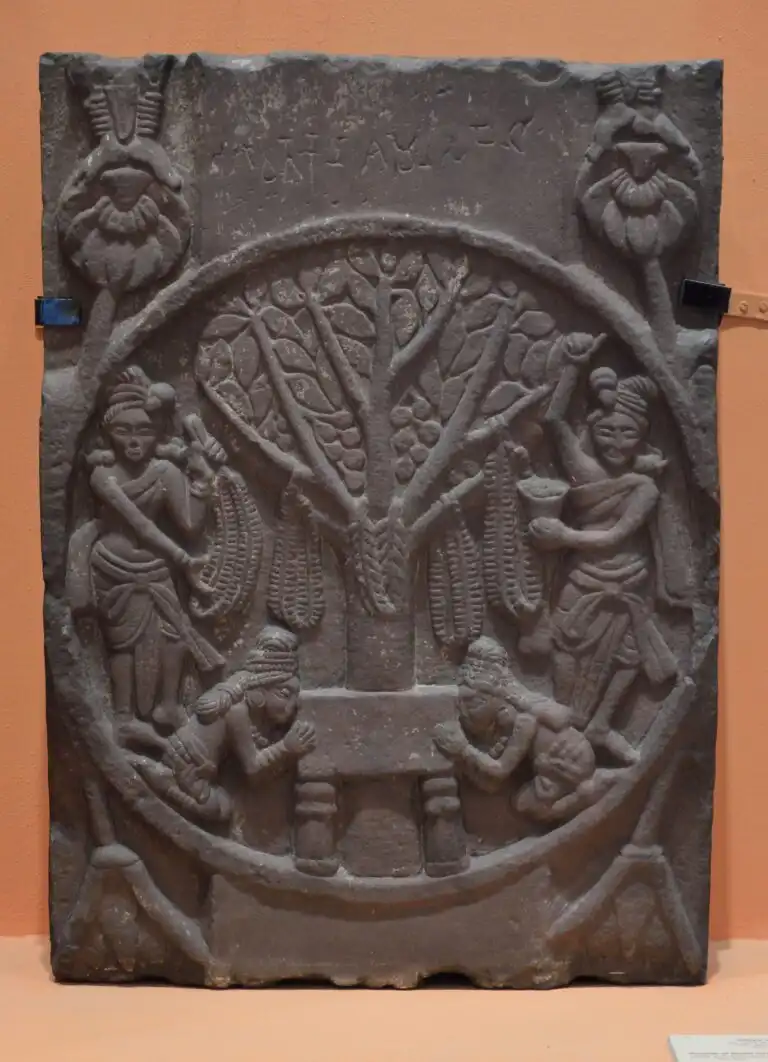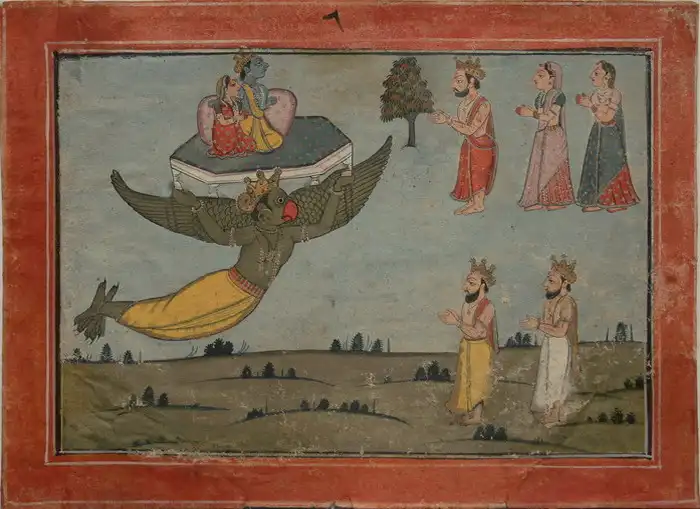Brahma: The Creator and Keeper of Universal Balance
Brahma, the Creator, is said to have awakened from a prolonged slumber within the cosmic golden egg, Hiranyagarbha. As he opened his eyes, he saw an empty expanse around him and felt a deep sense of loneliness. Determined to populate the universe with life, Brahma created several beings, known as his mind-born offspring. Among them were Angiras, Atri, Bhrigu, Chitragupta, Daksha, Himavan, Jambavan, Kama, Kratu, Kumaras, Marichi, Narada, Pulaha, Pulastya, Shatarupa, Sindura, Svayambhuva Manu, and Vashishtha.
Creation of Life and the Progeny of Kashyapa by Brahma
Svayambhuva Manu, often referred to as Manu, later became the progenitor of humanity on Earth. It is from him that the term “Manushya” or “Manav” (humankind) originates. Marichi, one of Brahma’s prominent mind-born sons, was the father of several children, including the Vedic sage Kashyapa, who played a vital role in the creation and propagation of life.
Kashyapa, the Vedic sage and progenitor of many life forms, is said to have fathered thirteen distinct groups of beings through his marriages with thirteen women.

They are:
- Surasa gave birth to sea snakes and other aquatic creatures.
- Kadru was the mother of the Nagas (serpents).
- Krodhavasha bore serpents.
- Khasa gave rise to the Rakshasas (demons) and Yakshas (nature spirits).
- Danu brought forth the Danavas (a clan of powerful beings).
- Diti gave birth to the Daityas (giants or asuras).
- Aditi was the mother of the Adityas (solar deities).
- Arishtha gave life to the Gandharvas (celestial musicians).
- Muni was the progenitor of the Apsaras (celestial nymphs).
- Tamara contributed to the animal kingdom through her six daughters.
- Surabhi gave birth to buffaloes and cows.
- Vinata was the mother of Aruna, the charioteer of Surya (the Sun god), and Garuda, the divine mount of Vishnu.
- Ila was responsible for the creation of all flora and wildlife, including trees, plants, and bushes.
Through these unions, Kashyapa played a vital role in shaping the diversity of life in the universe.
ALSO READ: Nataraja: Symbolism and Relevance in Contemporary Times
This fascinating tale links all life on Earth to Brahma’s creation, emphasizing that, despite spanning different generations, we are all descendants of Brahma. To maintain the balance of the system that Brahma established, it is essential for us to coexist harmoniously. This message of balance and harmony extends beyond mythology, finding expression in literature, rituals, and iconography as a timeless reminder of our interconnectedness.
Echoes of Creation: Brahma in the Vedas and Puranas
The Vedas frequently emphasize the importance of trees in human life. The Rigveda contains several verses that glorify trees, with Soma being their principal deity. For instance, Hymn 5.41.11 states: “May the plants, waters, and sky preserve us, and may the woods and mountains with their trees for tresses.” Similarly, Hymn 1.13.11 refers to Vanaspati (Lord of the Woods) as a source of wisdom. Furthermore, Hymn 5.5.10 equates the presence of trees with the presence of the gods, highlighting their sacred significance.
Sacred texts like the Puranas, Mahabharata, and Ramayana contain numerous references emphasizing the importance of planting and nurturing trees. The Kurma Purana narrates how Brahma created medicinal plants (Aushadhi), trees (Vriksa), and herbs (Virudha), stating that they emerged from Brahma’s skin pores. The Agni Purana elaborates on the plants and plant components to be used in religious rituals and offerings. Among these are species like Mallika, Ashoka, Kamla, Kumda, Tagara, and Sindhuvara, highlighting their sacred and ceremonial significance.

Divine Origins and Symbolism of Sacred Plants in Hindu and Buddhist Traditions
The Vamana Purana attributes the origins of various plant groups and species to different gods, assigning them a sacred significance. For instance, the Padma plant is said to have emerged from Prajapati’s navel, the Dhattura from Maheshwara’s heart, and the Palasa from Yama’s left body. This divine association grants many plants a special status tied to specific deities. The Vamana Purana also states that any flower with vibrant colors or a pleasant fragrance is suitable for religious rituals. Similarly, the Brahmavaivarta Purana regards plants as sacred, emphasizing that Brahma created many of them through his divine concentration.
According to the Vishnu Purana, one of the gems that emerged from the sea during the Samudra Manthana (Churning of the Ocean) was the Kalpavriksha, a wish-fulfilling tree. Many scholars associate the Kalpavriksha with the coconut tree. Another prominent motif found in Buddhist stories is the Ratnavriksha, or tree of jewels. Additionally, an intriguing tale mentions the Parijata, or night-flowering jasmine, further enriching the symbolism of sacred and magical plants.
Significance of Sacred Trees in Hinduism and Buddhism: The Parijat and Peepal
The Parijat tree is said to have existed only in Indra’s eternal garden in Swarga. One day, while strolling in the garden, Satyabhama and Krishna were walking together. In a playful act, Krishna broke off a branch from the Parijat tree and brought it down to the earth. This angered Indra, who, in his fury, cursed Krishna, declaring that the tree’s blossoms would fall before dawn, ensuring that no one could witness the Parijata in full bloom.
Both Buddhism and Hinduism place significant importance on the sacred fig, known as the Peepal tree. The Bodhi tree, a Peepal tree, is especially revered, as it is believed to be the tree under which Gautam Buddha attained enlightenment. Additionally, the Peepal tree is mentioned in the oldest written texts, such as the Rigveda and Atharvaveda.
Significance in Rituals
Several scriptures associate trees with different deities to highlight their value. Additionally, rituals connected to these deities in later periods further emphasize this connection. Krishna’s favorite plant is basil, or tulsi. He holds Vrindavan (the Tulsi forest) in greater esteem than any other place on Earth. Krishna performs the Raasleela, a heavenly dance, and plays his flute with great devotion in Vrindavan. In some stories, Shiva even changes his gender to join in the dance. The sacred union of Krishna and Vrinda/Tulasi is also mentioned in certain narratives.

The significance of Tulasi for Krishna is highlighted in a narrative involving Satyabhama and Rukmini. Although both were Krishna’s wives, Satyabhama took pride in the wealth she and Krishna shared, while Rukmini remained humble and desired only Krishna’s companionship. One day, Narada Muni informs Satyabhama that Krishna loves Rukmini more than her. Satyabhama, who prides herself on her beauty and believes she holds the most influence over Krishna’s heart, becomes enraged by this revelation.
The Tale of Tulsi: Rukmini’s Wisdom and the Power of Devotion
Narada devises a plan to challenge Satyabhama and prove her pride. He instructs her to accept the Tulabharam challenge, warning that if she fails, she will have to give Krishna as a gift. Narada further entices her with the promise that if she succeeds, she will win Krishna’s favor. In agreement, Satyabhama places her wealth on one side of the balancing scale (Tula) and requests that Krishna take the other side. Despite several attempts and spending all of her money, she is unable to outweigh Krishna.
Rukmini intervenes when she sees her husband on the Tula. Upon learning about the challenge, she picks a tulsi leaf and places it on top of the money stacked on the scale. Miraculously, the tulsi leaf outweighs Krishna. Rukmini demonstrates her deep understanding of what matters most to Krishna, proving that even a simple tulsi leaf holds more significance to him than all the riches. Tulasi continues to play an important role in religious rituals today. In several temples, Tirth (holy water) is prepared by soaking Tulasi leaves for hours. Additionally, Tulsi leaves are placed on food offerings before they are presented to deities or distributed as Prasad to devotees, purifying them in the process.
The Sacred Significance of Plants, Fruits, and Flowers in Hindu Rituals
Chandan (sandalwood) and Haldi (turmeric) are essential components in various ceremonies. For the deity’s Tilak (dot on the forehead), Haldi or Kumkum, made from Haldi, is used. In wedding ceremonies, a haldi paste—a mixture of water and aromatic oil—is applied to the bride and groom, taking advantage of its cosmetic properties. During Navratri, turmeric plays a significant role in the worship of goddesses and the folk deity Khandoba in Maharashtra. Chandan’s cosmetic qualities also contribute to its use. Women apply Kumkum, prepared from turmeric powder, on their foreheads, while men use Tilak made of Chandan.
Mango leaves are considered highly auspicious and are often used during significant events such as festivals, weddings, housewarmings, and important worship ceremonies. A torana, made of mango leaves, is typically placed over the front door to invite prosperity and good fortune. Banana leaves, in addition to being used for eating, are also utilized as plates for food offerings to the gods. During weddings and other important ceremonies, banana leaves are used as an auspicious element in the Manadapa.
Ancient texts link several fruits and flowers to specific deities. For example, Dhattura and Bel are favored by Shiva, Lotus is offered to Lakshmi, Parijata is associated with Krishna and Vishnu, Durva is offered to Ganesha, and Blue Kurinji is offered to Kartikeya, among others.

